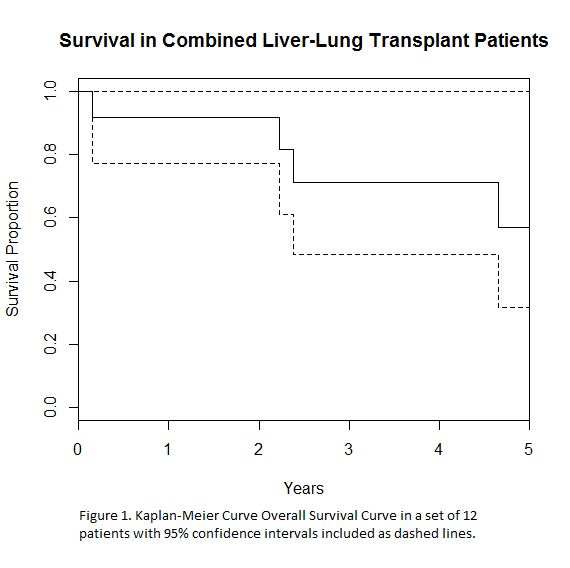Long-Term Analysis of Combined Liver-Lung Transplant Outcomes at a Single-Center.
1School of Medicine, Duke University, Durham, NC
2Surgery, Duke University, Durham, NC
Meeting: 2017 American Transplant Congress
Abstract number: B254
Keywords: Liver transplantation, Lung transplantation, Outcome, Survival
Session Information
Session Name: Poster Session B: Lung Transplantation Poster Session
Session Type: Poster Session
Date: Sunday, April 30, 2017
Session Time: 6:00pm-7:00pm
 Presentation Time: 6:00pm-7:00pm
Presentation Time: 6:00pm-7:00pm
Location: Hall D1
Purpose: Combined liver-lung transplantation (CLLT) is indicated in patients who would not be expected to survive transplantation of either organ alone. We present one of the largest and most recent series to date.
Methods: The UNOS database was queried for patients that underwent CLLT at our institution from 2000-2016. Statistical analysis was performed using R. Survival was plotted using the Kaplan-Meier method.
Results: Our hospital performed 12 CLLTs from 2000-2016. There were 9 male and 3 female recipients with a mean age of 33.7 years and BMI of 21. Indications for lung transplantation were cystic fibrosis (8), idiopathic pulmonary fibrosis (3), and pulmonary fibrosis secondary to hepatopulmonary syndrome (1). Indications for liver transplantation were cystic fibrosis (8), alcoholic cirrhosis (1), idiopathic cirrhosis (1), hepatoportal sclerosis (1), and alpha-1 antitrypsin deficiency (1). Average FEV1 at transplant was 27.8% and average MELD was 10.5. Median hospital stay was 44.5 days post-transplant. Overall patient survival percentage was 100% at 30 days, 90.9% at 1 year, and 62.5% at 3 years. At the time of analysis, 7 of 12 patients were alive with three patients alive at over 8 years post-CLLT. Three patients required lung re-transplantation. Of the deceased patients, the causes of death were primary graft failure (1), bronchiolitis obliterans syndrome (1), large cell lung adenocarcinoma (1), cholestatic liver disease and pneumonia (1), and squamous cell carcinoma of the eyelid and systemic nocardia (1).
Conclusions: An improved understanding of outcomes following CLLT is imperative to determine whether dual allocation of organs to a single recipient is justifiable. Here we present one of the largest US single-institution series, which showed that CLLT had a similar long-term survival rate to other major CLLT series and isolated lung transplantation. This complex procedure, however, carries a significant risk of morbidity and mortality, even at the most experienced centers. Large database analysis will be helpful in determining the future of organ allocation in this unique population.
CITATION INFORMATION: Freischlag K, Ezekian B, Mulvihill M, Knechtle S. Long-Term Analysis of Combined Liver-Lung Transplant Outcomes at a Single-Center. Am J Transplant. 2017;17 (suppl 3).
To cite this abstract in AMA style:
Freischlag K, Ezekian B, Mulvihill M, Knechtle S. Long-Term Analysis of Combined Liver-Lung Transplant Outcomes at a Single-Center. [abstract]. Am J Transplant. 2017; 17 (suppl 3). https://atcmeetingabstracts.com/abstract/long-term-analysis-of-combined-liver-lung-transplant-outcomes-at-a-single-center/. Accessed December 22, 2025.« Back to 2017 American Transplant Congress
